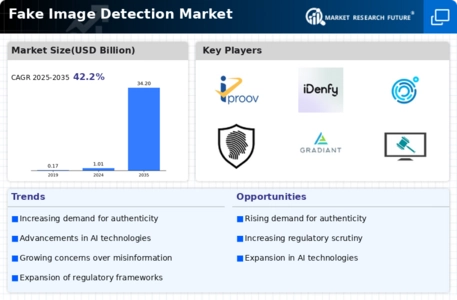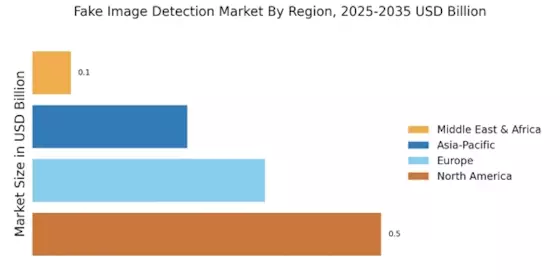The Fake Image Detection Market is currently characterized by a dynamic competitive landscape, driven by the increasing prevalence of digital content manipulation and the growing demand for authenticity in visual media. Key players such as Adobe (US), Google (US), and NVIDIA (US) are at the forefront, leveraging their technological prowess to innovate solutions that address these challenges. Adobe (US) focuses on integrating advanced AI capabilities into its Creative Cloud suite, enhancing user tools for detecting and mitigating fake images. Meanwhile, Google (US) emphasizes its cloud-based solutions, aiming to provide scalable detection services that cater to a diverse range of industries. NVIDIA (US) is strategically positioned through its powerful GPU technology, which supports real-time image analysis, thus enhancing the speed and accuracy of detection processes. Collectively, these strategies not only bolster their market positions but also shape a competitive environment that prioritizes technological advancement and user trust.
In terms of business tactics, companies are increasingly localizing their operations to better serve regional markets, optimizing supply chains to enhance efficiency. The market structure appears moderately fragmented, with a mix of established players and emerging startups. This fragmentation allows for a variety of approaches to fake image detection, fostering innovation while also creating competitive pressures among key players. The influence of major companies is significant, as they set industry standards and drive technological advancements that smaller firms often follow.
In August 2025, Adobe (US) announced a partnership with a leading social media platform to integrate its fake image detection technology directly into the platform's content moderation tools. This strategic move is likely to enhance the platform's credibility and user trust, as it actively combats misinformation and manipulated content. By embedding its technology within widely used applications, Adobe (US) not only expands its market reach but also reinforces its position as a leader in digital content integrity.
In September 2025, Google (US) launched a new initiative aimed at educational institutions, providing free access to its fake image detection tools. This initiative is significant as it fosters early adoption among future professionals, potentially creating a generation that prioritizes authenticity in digital media. By targeting educational sectors, Google (US) is likely to cultivate long-term brand loyalty and establish itself as a foundational player in the market.
In October 2025, NVIDIA (US) unveiled a new AI-driven platform designed to enhance the accuracy of fake image detection in real-time applications. This development is crucial as it positions NVIDIA (US) at the cutting edge of technology, appealing to industries that require immediate verification of visual content. The emphasis on real-time capabilities suggests a shift towards more proactive measures in combating digital deception, aligning with broader trends in AI integration across various sectors.
As of October 2025, the competitive trends in the Fake Image Detection Market are increasingly defined by digitalization, sustainability, and the integration of AI technologies. Strategic alliances among key players are shaping the landscape, fostering innovation and collaborative solutions. Looking ahead, it appears that competitive differentiation will evolve from traditional price-based strategies to a focus on technological innovation, reliability in supply chains, and the ability to provide comprehensive solutions that address the complexities of digital content authenticity.


















Leave a Comment